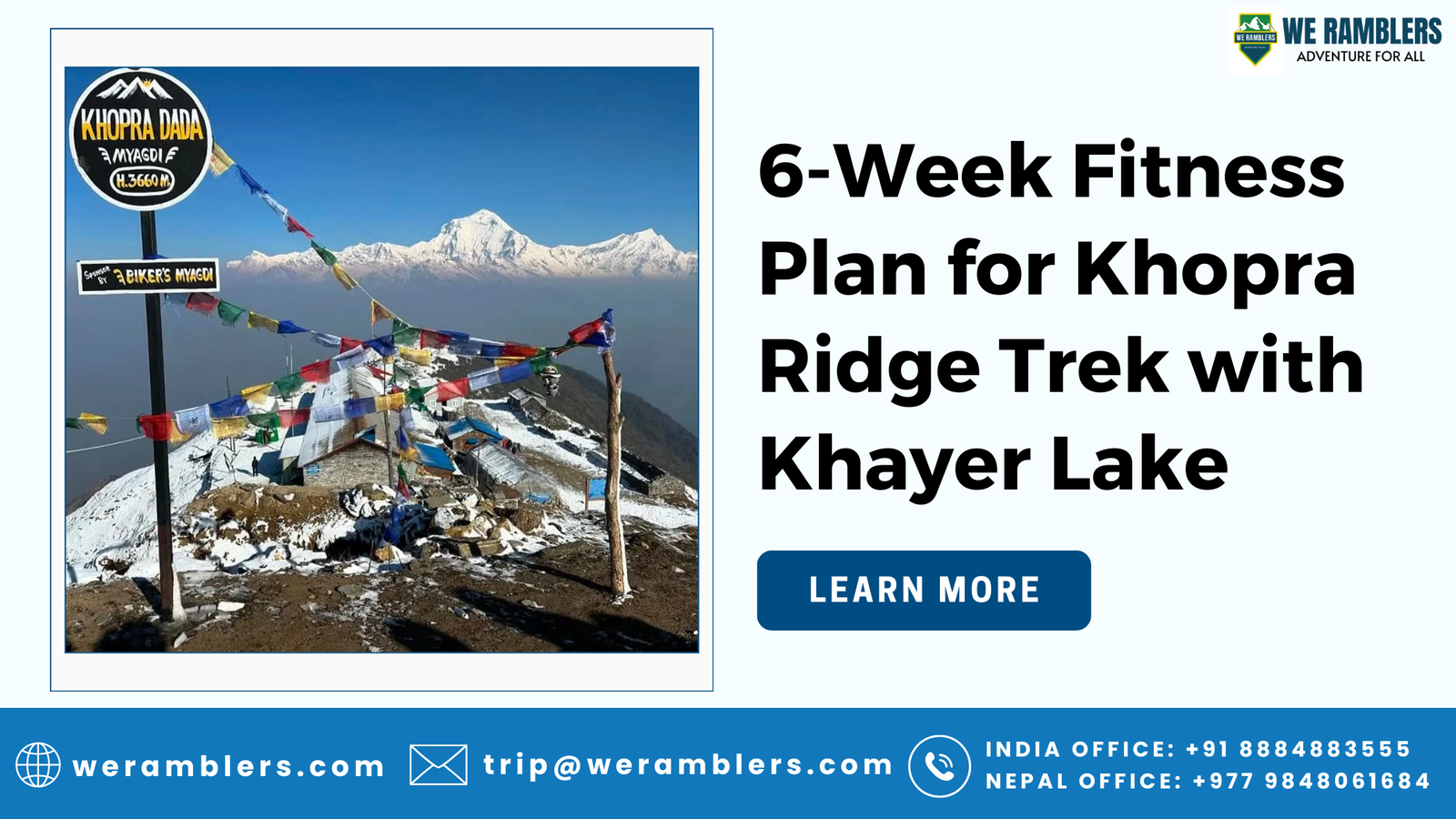6-Week Fitness Plan to Get Ready for Khopra Ridge & Khayer Lake
The Khopra Ridge & Khayer Lake Trek is one of Nepal’s most scenic and underrated Himalayan routes, offering panoramic views of Dhaulagiri, Annapurna, and Nilgiri peaks, along with the pristine turquoise waters of Khayer Lake (4,660 m). Though not as popular as Everest or Annapurna Base Camp, this trek rewards adventurers with raw beauty, cultural charm, and a truly peaceful experience.
But make no mistake; despite its moderate grading, the trail includes steep climbs, long walking hours, and high altitudes. That’s why following a structured Khopra Ridge training plan is essential to enjoy this Himalayan adventure safely and confidently.
Whether you’re a first-time trekker or an experienced hiker looking to push your limits, this 6-week fitness plan for Khopra Ridge and Khayer Lake will help you get physically and mentally prepared for the journey ahead.
Understanding the Khopra Ridge & Khayer Lake Trek
Before diving into the training details, let’s understand what makes this trek unique.
The Khopra Ridge trek branches off the classic Annapurna route and ascends to one of the most scenic ridge viewpoints in Nepal. It’s perfect for trekkers seeking solitude and adventure without the crowds. The detour to Khayer Lake, a sacred alpine lake nestled beneath the Annapurna range, adds an extra day and an unforgettable highlight.
Key Facts About The Khopra Ridge trek:
- Trek Duration: 8–10 days
- Maximum Altitude: 4,660 m (Khayer Lake)
- Trek Grade: Moderate to Challenging
- Best Season: March–May and September–December
- Route Highlights: Ghorepani, Dobato, Khopra Ridge, Khayer Lake
While the trek isn’t technical, it demands good endurance, especially during long ascents from Dobato to Khopra Danda and the steep climb to Khayer Lake. Hence, a dedicated Khopra Ridge training plan ensures you can handle the terrain, altitude, and distance comfortably.
Why You Need a Fitness Plan for Khopra Ridge
Even though the Khopra Ridge trail is considered suitable for beginners with basic fitness, it still involves trekking 5–7 hours per day, with several sections climbing over 1,000 meters in elevation gain.
Following a training for Khayer Lake program helps you:
- Build cardiovascular endurance for long hikes
- Strengthen leg and core muscles to handle steep climbs
- Improve balance and stability on uneven trails
- Enhance lung capacity for high-altitude trekking
- Prevent injuries and altitude sickness
Your goal isn’t to become a marathon runner; it’s to prepare your body to walk uphill for hours while carrying a daypack, keeping steady breathing, and enjoying every moment of the trek.
6-Week Khopra Ridge Training Plan
This structured 6-week Khopra Ridge training plan focuses on three key pillars: cardio, strength, and endurance. It’s designed for people of average fitness and can be done at home, in the gym, or outdoors.
Weeks 1–2: Foundation Building Phase
Goal: Develop basic stamina and build consistency.
Cardio for Trekking:
Start with 4–5 sessions of low-intensity cardio each week — brisk walking, cycling, swimming, or jogging for 30–45 minutes. Focus on keeping your heart rate in the aerobic zone (around 65–75% of max HR).
Strength Training:
Begin with bodyweight workouts to strengthen your legs, hips, and core.
- Squats – 3 sets of 12
- Lunges – 3 sets of 10 per leg
- Step-ups (using stairs) – 3 sets of 10
- Plank – 3 x 30 seconds
Hill-Walking Prep (Nepal-style):
Find a hill or stairway nearby and walk up and down for 30 minutes. This simulates real trekking conditions.
Tip: Focus on steady breathing. Controlled oxygen intake during workouts improves your ability to handle altitude.
Weeks 3–4: Strength and Endurance Phase
Goal: Increase cardiovascular endurance and build strength for steep climbs.
Cardio for Trekking:
Add 1–2 high-intensity interval training (HIIT) sessions per week. For example:
- 10-minute warm-up
- 4 rounds of (4 min fast pace + 2 min slow recovery)
- 10-minute cool-down
These sessions improve stamina and simulate the varied pace of trekking uphill.
Strength Training:
Add resistance or weights for progression:
- Weighted squats – 3 sets of 10
- Walking lunges – 3 sets of 12 per leg
- Step-ups with backpack (6–8 kg) – 3 sets of 10
- Mountain climbers – 3 sets of 15
- Side planks – 2 sets of 30 seconds
Weekend Long Hikes:
Start hiking once a week with a backpack weighing 6–8 kg. Cover 8–10 km on mixed terrain. This builds muscle endurance and replicates trail fatigue.
Weeks 5–6: Trek Simulation Phase
Goal: Mimic real trekking conditions and altitude intensity.
Endurance Workouts:
- Cardio 5 days/week (1 hour minimum each session)
- Alternate between hill hikes, jogging, cycling, and stair climbing.
- Include one long hike (12–15 km) every weekend carrying a 10 kg pack.
Strength & Stability:
- Step-ups with weight – 3 x 12
- Deadlifts – 3 x 10
- Squat holds – 3 x 30 seconds
- Push-ups – 3 x 12
- Plank with leg raise – 3 x 30 seconds
Breathing Training:
Practice deep diaphragmatic breathing to prepare your lungs for thinner air. Controlled breathing improves oxygen utilization and endurance at high altitude.
Mental Preparation:
The Khopra Ridge difficulty lies not just in the steep climbs but in maintaining motivation through changing weather and long walking days. Stay consistent and visualize reaching Khayer Lake; it builds mental strength.
Flexibility, Recovery & Nutrition
Flexibility
Include yoga or stretching 3–4 times weekly. Focus on your hamstrings, quads, hips, and shoulders. Yoga poses like Warrior II, Triangle Pose, and Cobra Pose improve flexibility and balance.
Recovery
Sleep for 7–8 hours, hydrate well, and allow at least one rest day weekly. Proper recovery helps muscles adapt and prevents burnout.
Nutrition
Fuel your body with:
- Complex Carbs: Brown rice, oats, whole grains for sustained energy
- Protein: Eggs, fish, lentils, and beans for muscle repair
- Healthy Fats: Nuts, seeds, and olive oil for endurance
- Hydration: Drink 3–4 liters of water daily — dehydration increases altitude sickness risk
Nutrition plays a vital role in your training for Khayer Lake, as it supports both performance and recovery.
Altitude and Acclimatization Tips
Altitude can affect even the fittest trekkers. Here’s how to prepare:
- Ascend gradually; follow “climb high, sleep low.”
- Stay hydrated and avoid alcohol.
- Take short breaks during steep climbs.
- Know AMS symptoms (headache, nausea, dizziness).
- Don’t rush your trek — enjoy the journey.
Practicing controlled breathing and pacing yourself during training simulates the rhythm of Himalayan trekking.
Final Thoughts: Conquer Khopra Ridge & Khayer Lake with Confidence
The Khopra Ridge & Khayer Lake trek may not be the highest or toughest in Nepal, but it’s one of the most rewarding for those who come prepared. Following this 6-week Khopra Ridge training plan ensures you have the endurance, strength, and mental focus to take on the challenge with confidence.
Remember: preparation is the difference between surviving a trek and truly enjoying it.
So lace up your boots, follow your training schedule, and get ready to witness the magic of the Annapurna region, from the windswept ridges of Khopra to the sacred stillness of Khayer Lake.
FAQs on Khopra Ridge Training Plan
1. How difficult is the Khopra Ridge trek?
The Khopra Ridge difficulty level is moderate to challenging. It doesn’t require technical climbing but involves steep ascents and long walking days, making physical preparation essential.
2. How long should I train before trekking to Khopra Ridge and Khayer Lake?
A 6-week Khopra Ridge training plan is ideal for most trekkers. It focuses on cardio, strength, and endurance — the key pillars of trekking fitness.
3. What is the best type of cardio for trekking in Nepal?
Cardio for trekking should include hill walking, stair climbing, and interval running to simulate mountain terrain and build stamina for long climbs.
4. How can I prepare for high altitude on the Khayer Lake trek?
To prepare for Khayer Lake, improve lung capacity through breathing exercises, stay hydrated, and train at a steady pace with rest days in between hikes.
5. Can beginners do the Khopra Ridge trek?
Yes! It’s a great choice for fit beginners who follow proper training. With the right Khopra Ridge training plan, even first-time trekkers can reach Khayer Lake safely.
Ready to Trek Beyond Ordinary? Join We Ramblers
Your Himalayan journey deserves more than just a trail; it deserves an experience. At We Ramblers, we specialize in guided treks across Nepal, Tibet, India, and Bhutan, including Khopra Ridge, Gokyo Ri, Annapurna Circuit, and Everest Base Camp.
With expert local guides, safety-first management, and small-group adventures, we ensure every trek is authentic, meaningful, and unforgettable.
- Professionally managed & fully serviced treks
- Expert local leaders with decades of experience
- Safety-first, eco-friendly adventure practices
- Personalized itineraries designed for real explorers
Take the first step toward your Himalayan dream. Book your trek with We Ramblers today, and experience the Himalayas like never before!





